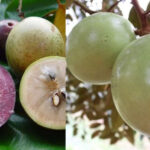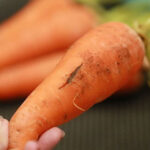The Piper lolot, also known as la lom or la giang, is a plant native to the northwestern mountainous regions of Vietnam. It typically grows wild in sparse forests, on hillsides, or in open fields, taking the form of a climbing vine that can reach several meters in height, with smooth green oval-shaped leaves.
In the local cuisine, la lom is not just a rustic delicacy but also a treasure trove of health benefits bestowed by nature. According to traditional Eastern medicine, these leaves possess cooling properties and a sweet-sour taste, known for their ability to effectively detoxify and clear heat. Locals often use la lom to treat various ailments such as skin inflammation, dysentery, malaria, stomach aches, boils, and skin issues like swelling, itching, or sores.
Furthermore, modern research has revealed that la giang leaves are rich in vitamin C and carotene, essential nutrients that boost the immune system and protect the body from diseases. With its special qualities, the Piper lolot plant deserves recognition not only in culinary applications but also in maintaining the well-being of individuals.

La giang leaves are packed with vitamin C and carotene, essential nutrients that strengthen the immune system and safeguard the body from illnesses.
When it comes to la lom-based dishes, one of the specialties that cannot be overlooked is thit trau nau la lom—a signature dish of the Muong ethnic group from northwestern Vietnam. This dish is a delightful fusion of the gentle sourness and refreshing taste of la lom leaves with the rich and savory flavor of buffalo meat. It not only adds variety to family meals but also brings a warm and cozy atmosphere.
Ingredients:
– 500g of buffalo meat, cut into bite-sized cubes.
– 200g of fresh la giang leaves, washed and torn into smaller pieces to better absorb the flavors.
– Seasonings: Salt, pepper, finely chopped garlic and shallots, fish sauce, sugar, and cooking oil.

When it comes to la lom-based specialties, one dish that stands out is thit trau nau la lom.
Preparation:
To prepare the buffalo meat cooked with la giang, start by gathering fresh and thoroughly cleaned buffalo meat and la giang leaves. Marinate the meat with salt, seasoning powder, pepper, and the chopped garlic and shallots. Let the meat absorb the flavors for about 15-20 minutes. Meanwhile, wash and tear the la giang leaves into smaller pieces.
Cooking Instructions:
– Prepare the pot: Place the pot on the stove, add cooking oil, and sauté the chopped garlic and shallots until fragrant.
– Stir-fry the meat: Once the garlic and shallots are aromatic, add the marinated buffalo meat and stir-fry until the meat is slightly seared, retaining its natural sweetness.
– Add water: Pour filtered water into the pot, ensuring it covers the meat. Bring it to a gentle boil.
– Cook the la giang: When the water is boiling, add the prepared la giang leaves and continue cooking for about 10-15 minutes. The tantalizing aroma of the dish will start to fill the air.
– Seasoning: Finally, adjust the taste by adding a little salt, sugar, and fish sauce to suit your preference.

Buffalo meat cooked with la giang leaves is best enjoyed with hot rice or fresh rice vermicelli.
Serving Suggestions:
– Serve the dish in a large bowl, and if you enjoy spicy food, feel free to add a few slices of fresh chili peppers.
– This dish pairs exceptionally well with hot steamed rice or fresh rice vermicelli.
As you gather around the table with your loved ones, each bite of tender buffalo meat infused with the gentle sourness of la giang leaves will not only delight your taste buds but also showcase the beauty of simplicity and the magic of nature that defines the cuisine of Vietnam’s northwestern mountainous regions.
The Secret to Choosing a Juicy, Sweet, and Thin-Skinned Sapodilla
Vú sữa is a popular fruit among many, but choosing a sweet and tasty one is no easy task. The art of selecting the perfect Vú sữa lies in a few key indicators; a keen eye and gentle touch will help you uncover the secrets to a delicious find.
The fruit’s appearance speaks volumes; a ripe Vú sữa boasts a vibrant yellow hue, with a hint of green at the stem. Its fragrance is another tell-tale sign, emitting a subtle, sweet aroma when ready to be enjoyed. But the true test of a Vú sữa’s ripeness is in its feel. A gentle squeeze will reveal a slight give, indicating the fruit is at its prime, ready to be savored.
With these simple tricks, you’ll be on your way to becoming a Vú sữa connoisseur, impressing your friends and family with your ability to select the finest fruits.
“The Ultimate Guide to Growing Vietnamese Coriander: Plant a Branch, Enjoy a Year’s Supply”
Introducing the art of growing Vietnamese Coriander, or ‘Lá Lốt’, a herb that adds a unique flavor to many Asian dishes. With its distinct aroma and taste, this herb is a secret weapon in the kitchen. The good news is that propagating this herb is a straightforward process, as this resilient plant has a high success rate when grown from cuttings. So, get ready to add some exotic flavor to your meals and impress your guests with your culinary prowess!
Should You Choose Large or Small Carrots When Shopping?
Carrots have earned the nickname “little ginseng” due to their abundant nutrient content, especially carotene. This humble root vegetable is a staple in households across the globe. To ensure you’re getting the best carrots, packed with flavor and nutrients, here’s a quick guide on how to select the finest ones.






































